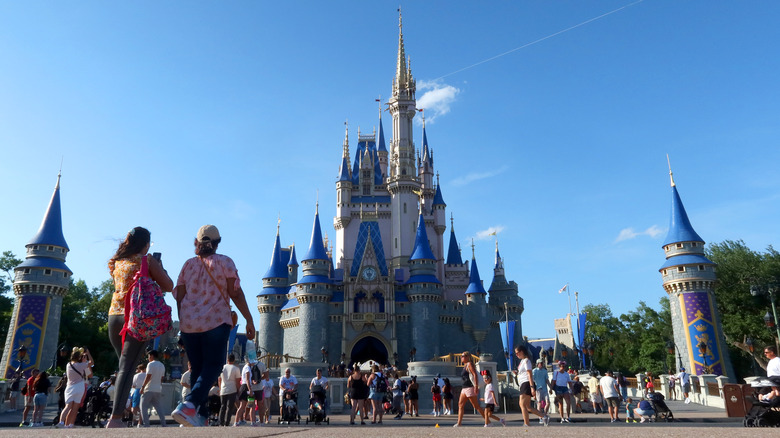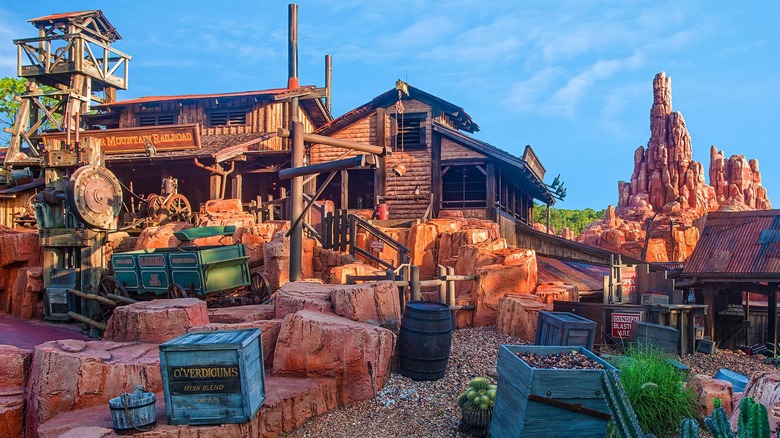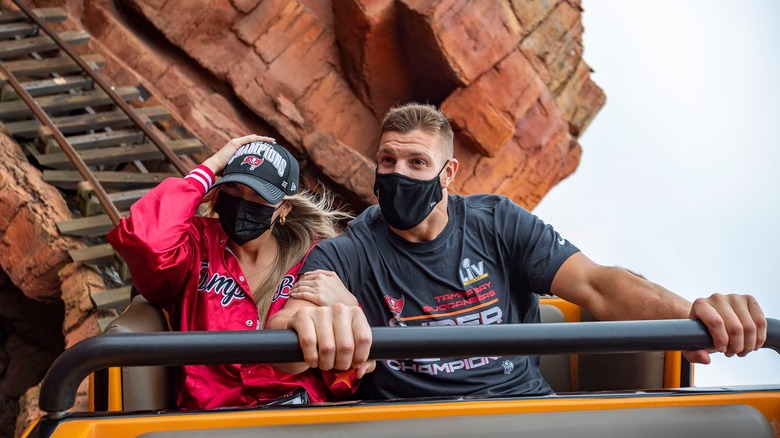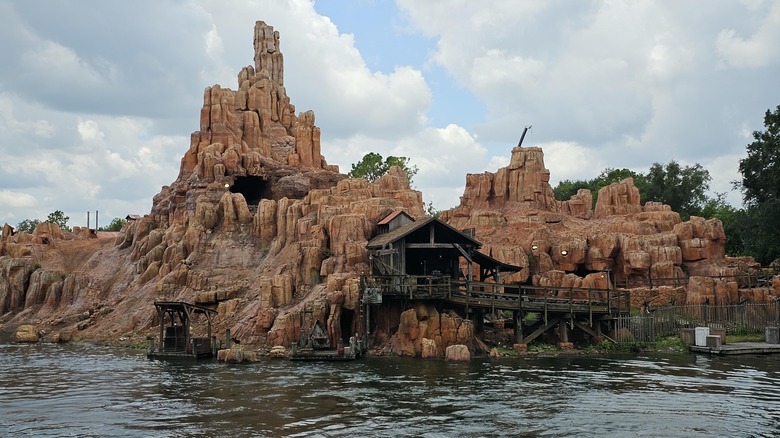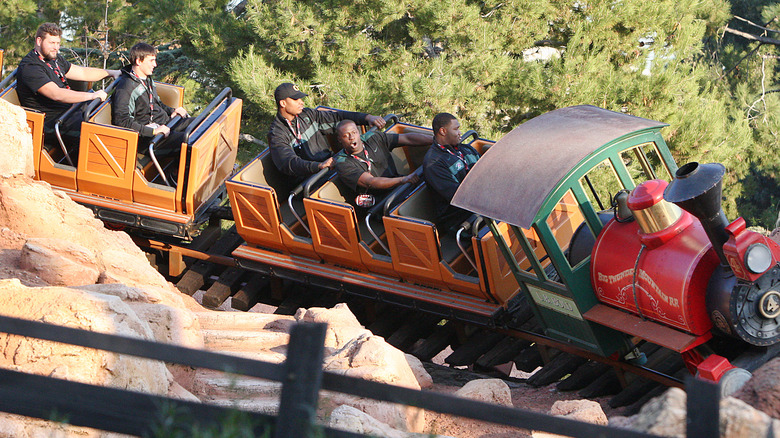Some Guests Claim This Popular Disney Park Ride Helped Them Pass Kidney Stones
Since 1980, the Big Thunder Mountain Railroad ride has been a fixture of Frontierland, the Western-themed area in the Magic Kingdom. What may surprise fans of one of the best Disney World roller coasters is that this ride has also pushed the medical frontier. In 2016, a study published in the Journal of the American Osteopathic Association determined that "certain roller coasters may help small kidney stones pass," including Big Thunder Mountain. The study was led by Dr. David Wartinger, a Michigan State University professor emeritus, who, in his own way, brought the spirit of early American pioneers to the unlikely niche of urology research at Disney.
Wartinger first undertook the study in 2008, but it wasn't until 2018, after the results had been publicized, that he won the Ig Nobel Prize for Medicine with it. That was the year Big Thunder Mountain took its place in the Annals of Improbable Research and weird Disney park facts. It was ushered in with a ceremony where an eight-year-old often interjects, "Please stop, I'm bored," during acceptance speeches for the Ig Nobel Prize (its name a satiric play on Nobel and the word "ignoble").
Boredom isn't as much of an issue when you're field-testing a Disney World thrill ride in the name of science. Wartinger's Ig Nobel was also grounded in a real experiment that involved repeated rides on Big Thunder Mountain. His objective was to gauge the merit of stories he'd been hearing from patients the ride allegedly helped.
A pattern developed on Big Thunder Mountain
For context, the Magic Kingdom's version of Big Thunder Mountain is one of four that opened in Disney parks worldwide from 1979 to 1992. The original Disneyland version drew inspiration from the red rock columns, or hoodoos, of Bryce Canyon National Park, one of the stops on Utah's Mighty 5 road trip. For Michiganders in East Lansing, however, it's a straighter shot down I-75 to Disney World.
Dr. Wartinger, himself an annual passholder at Universal Orlando Resort, told CBS News, "When spring break happens East Lansing becomes a ghost town. Everyone goes to the amusement parks, to Florida. My patients in large numbers would head to amusement parks in Orlando and I would hear them often coming back reporting this same thing so that it started striking my curiosity."
One patient claimed he rode Big Thunder Mountain three consecutive times and passed a kidney stone each time. Wartinger filled a 3D-printed silicone model of that patient's kidney with urine and three stones, then loaded it into a backpack and strapped it to his own body at kidney level. He proceeded to test it out himself on Big Thunder Mountain in Florida, initially riding the attraction 20 times. It just goes to show: You never know what kind of contraband people could be smuggling in their Mickey Mouse backpacks. Warringer, at least, had Disney World's permission, so this wasn't another project like "Escape from Tomorrow," the independent horror film shot guerrilla-style on Disneyland property.
Sitting at the back of the ride worked better
As Dr. Wartinger hitched his wagon to a different sort of train — one speeding through the mines of Big Thunder Mountain — he found that sitting at the back made his model kidney pass stones 63.89% of the time. Sitting in front only worked 16.67% of the time. He described this to the American Osteopathic Association as "anecdotal evidence that a ride on a moderate-intensity roller coaster could benefit some patients with small kidney stones."
Here, "small" is defined as less than four or five millimeters in diameter, with bigger kidney stones being more likely to get stuck and faster coasters being more likely to hold them in place with the force of gravity. As Wartinger and his co-author, Dr. Marc Mitchell, expanded the study to include 200 test runs with multiple kidney models, they got better results — an almost 70% passage rate when sitting in back of the ride vehicle. However, it soon became apparent that not all Disney World coasters are created equal.
Wartinger told CBS Baltimore, "In all, we used 174 kidney stones of varying shapes, sizes and weights to see if each model worked on the same ride and on two other roller coasters. Big Thunder Mountain was the only one that worked. We tried Space Mountain and Aerosmith's Rock 'n' Roller Coaster and both failed." According to him, "The ideal coaster is rough and quick with some twists and turns, but no upside down or inverted movements."
Other reports have surfaced on social media
In the years since Dr. Wartinger made his findings known, unsubstantiated reports of people passing kidney stones on Big Thunder Mountain have also circulated on social media. TikToker @gianamariefilms claims to have passed stones after riding Disneyland's version of the attraction five times in a row. Redditor u/Remote-Quantity7420 says they had two stones dislodge, only to block their ureter, while u/Beardedjerseygeek says they've passed at least one stone after every Disneyland trip.
In the latter case, the person first registered pain two days after a recent trip. The stones didn't come out until over a week later, so — as this was not a controlled study — there could have been other undocumented factors at play. It's worth noting that kidney stones small enough to be shaken loose on Big Thunder Mountain could leave your body naturally, without the need for any medical procedures, let alone a stiff regimen of roller coaster rides.
Wartinger's patients were luckier than Remote-Quantity 7420 or the two men who reportedly got kidney stones lodged in their urethra and ureter after bungee jumping and riding a roller coaster in Taiwan. With the bungee jumper, it was a 0.2-inch stone, which made it too large for the man to pass. If you have one or more bigger stones like that, it's possible that playing the human guinea pig on Big Thunder Mountain could backfire, leaving you in pain and making it necessary to cut your Disney trip short with a hospital visit.
The claim remains unproven despite its novelty appeal
The original claim that Disney World's version of Big Thunder Mountain can help dislodge kidney stones is still considered "unproven" on the fact-checking site, Snopes.com. Yet it's real enough to be documented in a peer-reviewed medical journal, so there's more substance to it than your typical Disney urban legend (like the one about Walt's body being frozen in cryonic storage). It could also be a fun excuse to ride and re-ride Big Thunder Mountain while potentially saving $5,000 to $10,000 on medical bills.
As Dr. Wartinger explained to the American Osteopathic Association, "Passing a kidney stone before it reaches an obstructive size can prevent surgeries and emergency room visits." The thinking is that coasters could be an unorthodox remedy for less serious cases before the problem gets worse and treatments like extracorporeal shock wave lithotripsy are necessary. "If you have a kidney stone, but are otherwise healthy and meet the requirements of the ride, patients should try it," Wartinger told CBS Baltimore. "It's definitely a lower-cost alternative to health care."
However, Wartinger also conceded to NBC News that, apart from its moderate intensity, Big Thunder Mountain doesn't necessarily hold unique properties as a coaster. "If you know you have a kidney stone and it is smaller than 4 mm, (you can try) going on a variety of amusement park thrill rides," he said. Before trying his ride remedy, though, it's probably best to get a second opinion from your own healthcare provider.
